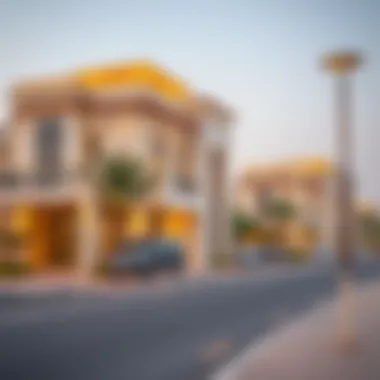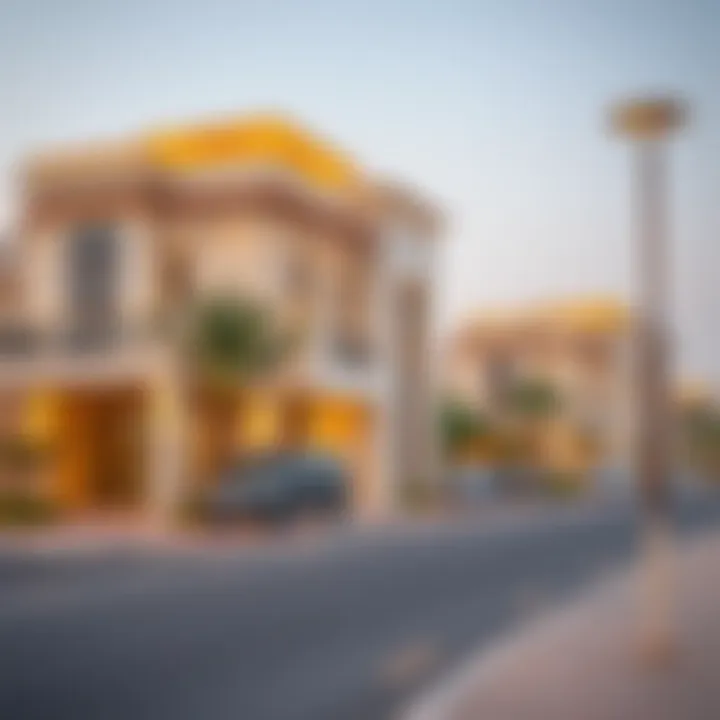Traveling on E101: A Guide from Abu Dhabi to Dubai


Intro
Traveling between two major cities in the UAE—Abu Dhabi and Dubai—is a common journey for tourists, businesspeople, and investors alike. The road that connects these two vibrant hubs, known as the E101, is more than just a highway; it serves as a critical artery for economic and social exchange. Understanding the dynamics of this route is essential for anyone considering a move or investment in the region. As one traverses the scenic landscapes, the journey reveals not only logistical considerations but also a glimpse of the broader economic trends shaping the real estate market.
This article will delve deeply into the various aspects of the E101 route, including the travel modalities available, cost efficiency, and the real estate opportunities that harmonize with the burgeoning economic realities. Let's explore what makes this journey unique, especially for prospective homebuyers, savvy investors, real estate agents, and expats setting their sights on new horizons.
Prelims to the E101 Route
Traveling between Abu Dhabi and Dubai along the E101 route offers individuals an essential corridor for both business and leisure. This superhighway is not merely a stretch of asphalt; it represents a vital connection in the United Arab Emirates, knitting together economic hubs and cultural spectacles. Understanding the nuances of the E101 route is pivotal for anyone who frequently traverses this path. The road is emblematic of the rapid development within the UAE and how accessible transport can bolster growth by linking key regions.
Overview of the Route
The E101 highway, often referred to as the Abu Dhabi-Dubai Road, efficiently stretches over 140 kilometers, making it a favorite for commuters, tourists, and logistics companies alike. This dual carriageway serves as a lifeline, facilitating the movement not just of people, but also of goods and services. Traveling this route rewards individuals with picturesque views of the desert landscape interspersed with modern architectural marvels that seamlessly rise against the horizon.
Moreover, the route is dotted with key landmarks that can enhance that very journey. For instance, the majestic Sheikh Zayed Grand Mosque stands just off the route near Abu Dhabi, offering a breathtaking initial impression. Further along, travelers often spot the dynamic skyline of Dubai, a sight that tempts many to explore its vibrant offerings. The E101 is not only about efficiency but also about experiencing the splendor of both emirates along the way.
Importance of E101 in the UAE
The E101 highway is significant in shaping the socio-economic landscape of the UAE. Its importance stretches beyond everyday convenience. Picture this: seamless transportation reduces wear and tear on business operations and connects remote areas with urban centers, fostering growth in regions that might have been otherwise isolated.
"The E101 is more than just a road; it's a pathway to opportunity."
In recent years, the UAE government has invested heavily in its infrastructure, recognizing that roads like the E101 are essential for tourism and economic activities. The flow of people and trade along this route has positive ripple effects: it leads to higher property values and encourages diverse investments from domestic and international buyers.
Business owners have been able to establish a foothold by leveraging proximity to both major cities. Whether it’s providing services to expats moving for work or facilitating logistics for goods between Abu Dhabi and Dubai, the E101 opens many avenues. The highway facilitates ease of movement, which is crucial for enhancing the overall economic dynamism of the UAE.
In short, understanding the E101 route transcends beyond mere navigation; it requires an appreciation of the impact it has on personal and economic landscapes within the region. It propels the UAE into a thriving axis where innovation and opportunity converge, making it an essential study for anyone aiming to invest or settle in the UAE.
Exploring Transportation Options
Traveling between Abu Dhabi and Dubai relies heavily on the available transportation options, making it a fundamentally crucial aspect for anyone pondering this journey. Each method of commute offers distinct advantages that can greatly influence a traveler’s experience. Understanding these options helps in optimizing travel plans, balancing cost and convenience, and enhancing overall enjoyment of the trip.
Driving: A Personal Perspective
Driving from Abu Dhabi to Dubai can be a liberating experience. For many, the freedom of setting one's own schedule is irreplaceable. The route itself is relatively straightforward and is lined with breathtaking desert views, not to mention the spray of modern architecture that marks Dubai's skyline. This personal journey not only allows travelers to explore at their leisure but can also lead to unplanned discoveries, such as roadside cafes or striking landscapes.
There is something unique about being behind the wheel in a region known for its vast deserts. The clarity of the open road can be invigorating. It’s worth mentioning that driving can also turn out to be cost-effective, especially for families or groups. The cost of fuel generally remains reasonable, meaning that you can travel comfortably without squeezing into public transit.
However, one must bear in mind the intricacies of local driving culture. Road etiquette differs markedly from that of other countries. Adhering to speed limits and respecting the locality's rules are non-negotiable. Also, it can be a wise move to familiarize oneself with potential traffic hotspots, especially during peak travel times, to sidestep unnecessary delays.
Public Bus Services
When considering budget-friendly options, public buses stand out prominently. The bus services between Abu Dhabi and Dubai provide a solid alternative that is efficient and honest on the pocketbook. Services like the E100 and E101 bus routes connect these two cities seamlessly, ensuring that residents and visitors can traverse the path without breaking the bank.
While buses may lack the privacy of a personal vehicle, they offer a chance to soak in the local atmosphere. The spacious interiors allow for a comfortable journey, with onboard amenities ranging from air conditioning to Wi-Fi on certain routes. The fares are nominal, typically not exceeding a few dirhams, making it suitable for both expatriates and tourists.
However, it’s important to consider the schedule. Buses can be infrequent during off-peak hours, and traveling during the day might lead to longer wait times. Quick tip: always check the schedules beforehand to avoid any unexpected delays.
Taxi and Rideshare Alternatives
In today's rapidly evolving urban environment, taxi services and rideshare options like Uber or Careem come in handy as flexible and often preferred methods of transport. Hailing a taxi or booking a ride via an app takes the hassle out of navigating unknown routes or battling traffic.
These selections provide immediate availability and superior comfort, allowing passengers to sit back and relax as they glide along the route. Many taxis in Abu Dhabi come equipped with meters, ensuring fair pricing. Rideshare apps can offer them same competitive rates, sometimes even better depending on promotions or offers.
Yet, it is essential to be mindful of surge pricing; this can occur during high-demand periods, typically during peak hours or significant events. As such, checking the rates beforehand could save money and avoid an unpleasant surprise.
Thus, each travel alternative between Abu Dhabi and Dubai has its distinct appeal, allowing travelers to select what's most convenient for their needs. The choice ultimately boils down to individual preferences regarding cost, convenience, and experience.
Travel Duration and Timing
Understanding the travel duration and timing between Abu Dhabi and Dubai is paramount for anyone making the journey. Not only does it help manage expectations, but it also influences decisions related to travel plans, meeting schedules, and even investments. The E101 route, a lifeline connecting these two major emirates, presents various layers of complexity in terms of time management.
Average Travel Times
On average, the trip between Abu Dhabi and Dubai takes about one hour and a half under normal conditions. However, it's essential to remember that this duration can fluctuate due to several factors. The distance spans roughly 140 kilometers, or about 87 miles, an easy stretch by road.


For those who may be accustomed to longer commutes, this travel time can seem quite appealing. However, it’s prudent to account for various elements that can extend this duration:
- Road conditions: Maintenance work or accidents can significantly slow down the flow of traffic.
- Weather conditions: Sandstorms or heavy rain can reduce visibility and speed.
- Time of day: Operating a vehicle in the early morning or late evening can offer more fluid travel experiences than midday.
Here’s a simple breakdown of travel times based on conditions:
- Clear conditions: 1 hour 30 minutes
- Moderately busy: 2 hours
- Heavy traffic: 2 to 3 hours
Peak Traffic Hours
Traffic congestion is a well-known issue on the E101, especially during peak hours. Commuting patterns indicate that weekday mornings and late afternoons are when the roads are most packed.
From 7 AM to 9 AM, and then again from 4 PM to 6 PM, expect a noticeable uptick in vehicles. During these times, it’s not uncommon for travel times to double, turning the quick jaunt into a drawn-out ordeal. If one needs to travel during these hours, it might be sensible to leave at least 30 minutes to an hour earlier than anticipated.
To provide a clearer picture, here’s what peak hours look like:
- Morning rush: 7 AM - 9 AM
- Lunch break: 12 PM - 2 PM (this is often hit or miss)
- Afternoon/evening rush: 4 PM - 6 PM
Traveling exactly during these congested times could require recalibrating plans. Not only does understanding this aspect empower you to save time, but it also reflects on broader lifestyle choices such as commuting to work or assessing real estate locations.
As you contemplate the trip, remember: planning ahead is your best ally. Knowledge of travel durations and peak traffic hours can translate into a smoother, less stressful journey, allowing you to focus on your destination and what lies ahead.
Cost Considerations for Travelers
When embarking on a journey between Abu Dhabi and Dubai via the E101 route, understanding the costs involved is critical for both seasoned travelers and first-timers alike. This section delves into the financial aspects of the trip, covering fuel expenses for those driving, the affordability of public transport, and the pricing structures of taxi services and rideshare options. Getting a grip on these elements is essential for budget planning and making the most of your experience on this well-traveled pathway.
Fuel Costs and Driving Expenses
Driving along the E101 can be a thrilling journey, but it’s important to keep an eye on the fuel costs. One must consider the current price of petrol in the UAE, which can fluctuate depending on global oil prices. On average, unleaded petrol tends to be cheaper here than in many Western countries, making it a viable option for local travelers. This usually hovers around 2.1 to 2.5 AED per liter, dependent on both the type of fuel and the oil company.
However, the expenses don’t stop there. Beyond fuel, don’t forget about toll charges for the Salik system once you enter Dubai. Each passage through a toll gate incurs a charge that can add up, particularly for frequent travelers.
Key Fuel Expense Considerations:
- Distance Coverage: The E101 is approximately 140 kilometers one way, indicating potential fuel consumption depending on your vehicle's efficiency.
- Toll Charges: Salik costs 5 AED per pass, so budget for this if driving through toll gates.
In summary, while fuel prices remain reasonable, it’s vital to track your routes and any fluctuating expenses that might impact your wallet during the drive.
Public Transport Fare Analysis
If driving isn’t your cup of tea, public transport offers a budget-friendly alternative. The bus service from Abu Dhabi to Dubai is not only economical but also convenient. A one-way ticket on the bus costs around 25 AED, compared to the cost of fuel and tolls for driving yourself. Given the high-quality service, this option might pique your interest, especially for those wishing to avoid the fuss of navigating the roads.
Public Transport Benefits Include:
- Comfort: The buses are air-conditioned and quite spacious, providing a comfortable ride.
- Frequent Schedules: Buses run regularly, with departures every 30 minutes, making it easy to find a ride that fits your schedule.
Utilizing public transport allows you to sidestep the stress of traffic and parking while enjoying the scenic views along the way.
Taxi and Rideshare Pricing Structures
Taxis and rideshare services like Uber could be an appealing choice for those seeking convenience without the headache of parking. Taxis in the UAE have a starting fare of approximately 12 AED, plus 1.82 AED for each kilometer traveled. In comparison, rideshare pricing can fluctuate based on demand, but it generally starts a bit higher than traditional taxis.
Taxis and ridesharing bring flexibility, especially during peak hours when public transport might be crowded.
Considerations When Choosing This Option:
- Peak Times: Fares can surge during rush hours or weekends, so time your ride wisely to avoid unexpected costs.
- Availability: In areas like Abu Dhabi and Dubai, getting a taxi or booking a rideshare is usually swift, enhancing convenience when you’re on-the-go.
When factoring these expenses into your travel budget, remember to consider not only the distance traveled, but also the timing and demand, which may change the pricing.
Through careful analysis of these cost considerations, travelers can better prepare for their journey between Abu Dhabi and Dubai, ensuring a smooth and economically manageable experience.
Scenic Route Highlights
Traveling between Abu Dhabi and Dubai offers more than just a way to cross the desert; it's an opportunity to immerse oneself in the rich culture and striking landscapes of the UAE. The E101 route offers numerous captivating sights that make for a memorable journey. Understanding these scenic highlights not only enriches the travel experience but can also be beneficial for those considering investing in properties along the route.


As you traverse this vital artery, you'll notice that each landmark and cultural aspect tells a part of the broader narrative of the UAE's development and heritage. With that in mind, we'll delve into two main sub-sections: the landmarks that punctuate this route and the cultural nuances that are key to grasping the local identity.
Landmarks Along the Way
Driving along E101, travelers are greeted by iconic landmarks that serve as both waypoints and points of interest. Notable among these are the following:
- Sheikh Zayed Grand Mosque: A beacon of modern Islamic architecture, this mosque is not just a place of worship but a symbol of tolerance and appreciation of culture. With its stunning white domes and intricate carvings, it invites exploration.
- Yas Island: Known for its entertainment options, Yas Island is home to attractions like Ferrari World, Yas Waterworld, and the Yas Marina Circuit. For investors, this area showcases the blend of leisure and luxury that attracts both tourists and residents alike.
- Abu Dhabi Desert Safari: On the outskirts of the E101, desert safaris offer a glimpse into the traditional Bedouin lifestyle. The golden dunes are not just stunning; they encapsulate the spirit of adventure that the UAE embodies.
- The Louvre Abu Dhabi: This magnificent art and civilization museum illustrates the UAE's commitment to fostering cultural exchange. With a structure as stunning as its exhibits, this landmark is essential for art lovers.
- Dubai Miracle Garden: As you approach Dubai, the Miracle Garden dazzles with its vibrant floral displays, providing a delightful break from the drive. Its vastness and creativity reflect the UAE's affinity for innovation in all aspects, even in landscaping.
These landmarks emphasize not only the aesthetic beauty of the E101 route but also its significance as a corridor of culture and modernity.
Cultural Aspects to Observe
As you journey along the E101, you will also find rich cultural elements that are synonymous with the UAE’s identity. Being cognizant of these aspects can greatly enhance your travel experience, especially for future expats or investors. Here's what to keep an eye out for:
- Hospitality: The warmth and openness of the Emirati people is legendary. Engaging with locals, or even enjoying a traditional meal, provides an insight into their way of life.
- Traditional Markets (Souks): Cities along the route often host markets where you can experience the local craft and commerce. Take some time to explore the vibrant souks, which offer a variety of products, from spices to jewelry.
- Architecture: The juxtaposition of ultra-modern skyscrapers with traditional buildings tells a story of progress. Look for cultural centers that showcase this unique architectural heritage and the growing art scene that thrives within these spaces.
"Understanding the cultural landscape along E101 can significantly shape your experience and investment decisions."
This exploration of landmarks and cultural aspects provides a well-rounded view, ensuring your journey on the E101 is more than a mere transit from one city to another; it becomes a tapestry of experiences worth savoring.
Real Estate Insights Along E101
The real estate landscape along the E101 route serves not only as a window to investment potential but also as a compass guiding prospective residents towards a comfortable and fulfilling lifestyle. This section taps into the heart of the matter, providing crucial insights into living arrangements and the ever-evolving market conditions that accompany this vital roadway.
Residential Developments Near the Route
Nestled along the E101, a variety of residential developments have sprung up, effectively bridging the gap between Abu Dhabi and Dubai. These neighborhoods cater to a wide array of residents, from young professionals to families, looking to harness the benefits of convenient commuting.
Some notable areas include Al Reem Island and Saadiyat Island in Abu Dhabi, which are increasingly popular choices thanks to their modern designs and proximity to key amenities. In Dubai, areas like Jumeirah Village Circle (JVC) and Dubai Sports City attract those who value affordability without compromising quality of life.
Key Features to Look for:
- Community Amenities: Look for developments that offer parks, schools, and retail options to ensure a well-rounded lifestyle.
- Connectivity: Properties that boast easy access to the E101 and public transport options tend to maintain their value better over time.
- Future Developments: Stay informed about upcoming infrastructure projects that can affect property values and living conditions.
It’s noteworthy that potential homeowners and renters have several options ranging from high-rise apartments to sprawling villas, each designed to accommodate an array of tastes and budgets. As demand increases along this route, it’s crucial to conduct thorough research to find a suitable fit in terms of both investment and lifestyle.
Investment Opportunities in Dubai
Investing in real estate along the E101 provides unique advantages due to the rapid urbanization and economic growth in Dubai. Sheikh Zayed Road and its connecting areas are arenas for substantial development, making it attractive to astute investors looking for fruitful opportunities.
Why Invest Here?
- Rising Demand: With more individuals moving from Abu Dhabi to Dubai, the demand for housing is expected to continue rising, pushing property values up.
- Government Initiatives: The UAE government has implemented various schemes, such as long-term visas for investors and expats, fostering a more stable and appealing investment environment.
- Strategic Location: Properties along the E101 hold appeal for those looking to strike a work-life balance, offering easy access for commuters and proximity to upscale amenities.
Things to Consider:
- Market Trends: Keep an eye on fluctuations in supply and demand to make an informed decision regarding timing.
- Property Management: It may be wise to utilize property management services if you invest in multiple units, especially if you do not reside in the UAE.
- Exit Strategy: Identifying a clear exit strategy before entering a market is crucial. Understanding how long you plan to hold onto the investment can significantly affect your profit margins.
"Investing in properties along E101 not only provides potential for capital appreciation but also enhances lifestyle choices available to the contemporary resident."
Living Arrangements and Amenities
Living arrangements and amenities play a crucial role in shaping the lifestyle of those who move from Abu Dhabi to Dubai. Understanding these elements not only informs potential investors but also helps new residents to adapt to their environments better. When deciding on residential options, factors like proximity to work, availability of public services, and the general vibe of the neighborhood come into play. Unraveling these dimensions can make the journey smoother and more enjoyable.
Housing Options in Dubai
Dubai presents a plethora of housing options that cater to various tastes and budgets. From luxurious villas in gated communities to chic apartments in bustling neighborhoods, the choices can be overwhelming yet exciting. This variety allows future residents to find a place that suits their needs perfectly.
- Luxury Living: Areas like Palm Jumeirah and Downtown Dubai offer opulent high-rises and villas with stunning views, catering to those who seek a lavish lifestyle.
- Affordable Housing: For those who prefer more economical choices, neighborhoods like Jumeirah Village Circle and Discovery Gardens provide budget-friendly apartments without skimping on amenities.
- Family-Friendly Areas: If you have a family, consider areas like Arabian Ranches or Dubai Hills Estate, where you will find parks, schools, and community centers, fostering a nurturing environment for children.
It's wise to check local listings and perhaps visit a community or two before making any decisions. Each area has its own flavor and distinct set of advantages.
Essential Services and Infrastructure
A robust infrastructure is paramount when considering a new home. In Dubai, the essential services are not only functional but also enhance the overall quality of life. Here are some key services to keep in mind:


- Healthcare: The healthcare system in Dubai is well-developed. There are numerous public and private hospitals, clinics, and pharmacies, ensuring that residents have access to quality medical care. Some notable hospitals include the American Hospital and the Dubai Hospital.
- Education: Parents will find a range of choices from international schools to local curriculums. Institutions like the British School Al Khaleej International and Our Own English High School are popular among expats.
- Transportation Services: With an efficient public transport network, including the Dubai Metro and buses, residents can commute easily. The Etihad Rail project is also underway, promising to enhance connectivity even further in the near future.
- Recreational Amenities: Dubai is known for its lush parks, shopping malls, and entertainment complexes. Areas like Dubai Marina and the Dubai Mall not only provide leisure options but also foster community interaction.
In summary, moving to Dubai involves much more than finding a place to live. The integral combination of housing options and essential services determines overall comfort and satisfaction. Taking the time to research and explore these aspects will undoubtedly lead to a more fulfilling life in this vibrant city.
"Investing in a home isn’t just a financial decision; it's where memories are made, and experiences unfold."
For more information about living in the UAE, you can check out resources on UAE Real Estate or Expatica.
Understanding these dynamics helps create a strong foundation for anyone looking to start a new chapter in Dubai.
Moving from Abu Dhabi to Dubai: Logistics
Relocating from Abu Dhabi to Dubai offers unique challenges and opportunities that one should address carefully. Understanding the logistics involved can significantly ease the transition, allowing for a much smoother experience. This section delves into the essential elements of planning a move, hitting on preparations and the rental market, which are crucial for making informed decisions.
Preparing for the Move
Moving isn't just about loading boxes into a truck; it's about proper planning. Initially, you’ll want to consider the timing of your move. The weather in the UAE can be dry and scorching hot, particularly from June to September. Choosing an earlier or later month might help sidestep the extreme heat.
Start making lists. Jot down what items you are taking with you and what you might need to buy once you’ve settled down in Dubai. Decluttering is essential—better to let go of things you no longer need than to pay to move them.
When moving your belongings, you can opt for a professional moving service or tackle the task on your own. Professional movers can be a golden choice—less stress on your shoulders but expect to pay for the convenience. If you decide to manage it independently, remember to pack wisely: box up heavier items at the bottom and lighter items on top.
Logistics also involve notifying important parties of your change of address. Update utility companies, banks, and any subscriptions you have so that you don’t miss a beat post-move.
Understanding the Rental Market
As you venture into Dubai’s ever-evolving real estate market, it's important to approach it with a well-informed mindset. The rental market can be quite diverse; prices and availability fluctuate greatly depending on the area.
Consider exploring neighborhoods such as Dubai Marina, Jumeirah Beach Residence, and Downtown Dubai. Each area boasts its perks and price points. For instance, while Dubai Marina offers stunning waterfront views, it comes at a premium. On the other hand, areas like Dubai Sports City might provide more competitive pricing, albeit with fewer amenities in comparison.
Here are some points to ponder when diving into the rental market:
- Research Areas Thoroughly: If you have specific needs—like schools or proximity to work—take those into account.
- Understand Rental Contracts: Rental contracts in Dubai can be a little labyrinthine, with stipulations regarding the duration and deposit amounts. Take your time to read the fine print.
- Budget for Costs Beyond Rent: Keep in mind that living in Dubai often means extra costs—utilities, maintenance fees, and community service charges can add up.
- Engage Real Estate Agents: Connecting with a reliable real estate agent could be the ace up your sleeve. They can provide insights into market trends and help find places that might just never be listed publicly.
"The best thing about moving is that you can start fresh and make your own place feel like home. Don’t rush; the right space is out there!"
By preparing thoughtfully and understanding the dynamics of the rental market, moving from Abu Dhabi to Dubai can transform from a daunting task into an exciting new chapter.
Epilogue: Factors to Consider
When contemplating a move or travel along the E101 route from Abu Dhabi to Dubai, it’s essential to mull over various factors that can shape your experience. This conclusion isn't merely an endcap; it's a crucial synthesis of insights that can help individuals make strategic decisions regarding their journey and surroundings.
One facet worthy of attention is the travel dynamics between Abu Dhabi and Dubai. While the distance might seem trivial—averaging around 1.5 hours under optimal conditions�—peak hours transform this short drive into a test of patience. Thus, understanding your travel schedule is key. Whether you're commuting daily for work or planning a leisure trip, timing can dictate your overall experience.
The costs associated with different modes of transport also merit consideration. When you're crunching the numbers, factoring in the price of fuel, public transport tickets, or rideshare fares can enlighten choices. Each method comes with its pros and cons, and aligning these with your financial strategy is not just smart—it's necessary.
Moreover, the socioeconomic landscape surrounding the E101 adds another layer of complexity. Housing options abound, but they vary widely in price and type. It’s essential to keep an eye on the real estate market, especially since the proximity to the E101 route can translate into significant investment potential. Whether you’re a homebuyer wanting to settle down or an investor scouting for lucrative opportunities, the implications of residing near this vital roadway cannot be overstated.
As potential residents or frequent travelers, balancing these factors grants you informed agency over choices that impact your lifestyle and finances. Ultimately, this guide aims to arm you with understanding before you take the leap—whether it be a move to a new city or navigating the busy roads.
Making Informed Travel Decisions
Making wise travel decisions hinges on several interlocking factors. What may seem tempting can change rapidly depending on variables like time, costs, and overall convenience. For example, while the idea of hopping into a taxi might feel like an easy solution, the cumulative costs over several trips can stack up quicker than one may anticipate.
Evaluating alternate transportation, like public buses, unveils a pocket-friendly solution. Still, you'll want to consider travel time and frequency. Delve into resources that help you track bus schedules and real-time traffic updates to gauge optimal routes.
- Factors to Evaluate for Travel Choices:
- Cost: Compare total travel expenses, including both direct fares and indirect costs like maintenance for personal vehicles.
- Time: Look into average travel durations versus peak traffic times to identify best travel windows.
- Convenience: Weigh personal comfort against financial outlays.
Making informed decisions allows you to tailor your journey, ensuring smooth transitions rather than unhappy surprises.
Real Estate Implications of the E101 Route
The real estate landscape surrounding the E101 is more than just transient; it's a hotspot for both homebuyers and investors. The appeal lies in accessibility, combined with the promising returns in real estate value.
For prospective buyers and financiers, understanding location is crucial. Properties on or near this road are constantly in demand, presenting opportunities that can yield high returns.
Key aspects to consider include:
- Potential Rental Yields: Locations along the E101 often fetch higher rents due to their connectivity, making them appealing to landlords as well.
- Future Developments: The government’s infrastructural investments in the area signal growth and desirability, paving the way for significant property value increases down the line.
- Market Trends: Keeping an eye on real estate trends will help shape investment strategies. Watch for indicators such as average price per square foot in nearby neighborhoods to make educated decisions.
Buying property along the E101 can be financially beneficial, given that the route acts like a vein transporting people and commerce between Abu Dhabi and Dubai. Pledging to stay informed on local trends is key to reaping the most benefits in an ever-expanding marketplace.







